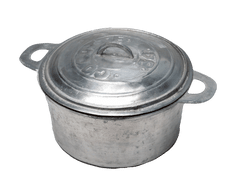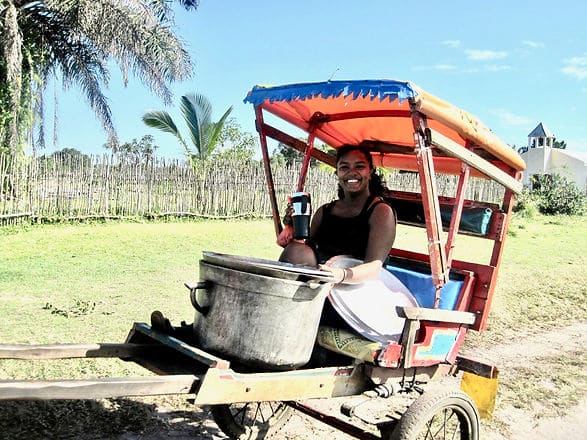Presented by Museum of the Peace Corps Experience and American University Museum
Early twenty-first century
Madagascar
Aluminum, 7 1/4 x 13 x 9 1/2 in.
Collection, Museum of the Peace Corps Experience
Gift of Teena Curry, Madagascar, Mananjary 2010-13

When my fellow volunteers and I arrived at the Girls Leading Our World (GLOW) camp, the cook assumed that we would bring a pot large enough to make rice for 25 or 30 people. All I brought was a small rice cooker. After a few moments thinking how to solve this problem, we were able to locate a church in town that was willing to lend us a very large pot—too large to carry back to camp with my bike. No worries: I brought it to the camp in a rickshaw.
Both pots may be considered as metaphors for a very special aspect of our group of Peace Corps volunteers: we were true examples of the American melting pot. I was born in India and grew up in the US. The others at our GLOW camp included Asian American, African American, and Mexican American volunteers. We also had several members belonging to the ethnic group that attendees expected to be the leaders at the Peace Corps GLOW camp: White Americans. The girls and chaperones did not expect so many brown faces that resembled their own in a group of American volunteers.
Many people who now live in Madagascar originated from both Africa and South Asia. A number of Malagasy people look like me, and I was often assumed to be a local Malagasy. There were some benefits to this: I could blend into crowds, escape curiosity or harassment, and bargain for lower prices. On the other hand, people expected me to be familiar with their customs and language. I think I was able to gain deeper trust in sensitive situations—for example, when mothers came to the clinic to discuss their pregnancies or to have their children vaccinated.
When it comes to interactions with people who are different from us, we each carry our small, individual pot. The Malagasy people had scant knowledge of American history or diversity, and I had limited knowledge of their customs and beliefs.
The third goal of the Peace Corps is all about creating a large melting pot—a huge pot that includes all of humanity, too big for your typical rickshaw or even for a lifetime of travel and service. I learned from my Peace Corps experience that the more we understand others, and the more deeply they understand Americans (in all their colors), the safer our world will become.

The Committee for a Museum of the Peace Corps Experience is a 501(c)(3) private nonprofit organization. Tax ID: EIN # 93-1289853
The Museum is not affiliated with the U.S. Peace Corps and not acting on behalf of the U.S. Peace Corps.
Museum of the Peace Corps Experience © 2024. All Rights Reserved.